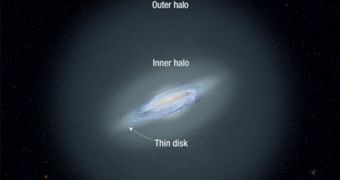According to the conclusions of a new series of astronomical observations, it would appear that white dwarfs in the Milky Way's halo are around 11.5 billion years old. This makes them a lot older than other stars located near the galaxy's core.
Previously, measurements indicated that these objects were between 10 and 14 billion years old, but scientists were unable to provide more precise figures. The new research, carried out by experts in the United States, sought to refine these numbers by as much as possible.
The investigation was led by scientist Jason Kalirai, who holds joint appointments with the Space Telescope Science Institute (STScI) and the Johns Hopkins University’s (JHU) Center for Astrophysical Sciences (CAS), both in Baltimore, Maryland.
In order to understand how our galaxy evolved to its current configuration – by consuming smaller galaxies and producing or gathering new stars – it is important to determine the age of as many stellar families as possible.
Since this is an extremely complex task, astronomers were stuck for quite a while. The new study was designed to provide an alternative means of continuing investigations into this matter. Kalirai focused on white dwarf since these objects are helium-burning remnants of Sun-like stars.
They also constitute the majority of stars in most galaxies. What the team found was that the white dwarfs in the Milky Way halo – a spherical structure around the galactic core, resembling a bulge – are just 2 billion years younger than the Universe. The latter started forming 13.75 billion years ago.
What this finding suggests is that our galaxy formed in stage, acquiring new stellar populations in waves, depositing them in a layered pattern around its core, and creating a cosmic cake of sorts.
“One of the biggest questions in astronomy is, when did the different parts of the Milky Way form. Sun-like stars live for billions of years and are bright, so they are excellent tracers, offering clues to how our galaxy evolved over time,” Kalirai says.
“However, the biggest hindrance we have in inferring galactic formation processes in the Milky Way is our inability to measure accurate ages of Sun-like stars,” the investigator goes on to say, quoted by Astrobiology Magazine.
“In this study, I chose a different path: I studied stars at the end of their lives to determine their masses and then connected those masses to the ages of their progenitors. Given the nature of these dead stars, their masses are easier to measure than Sun-like stars,” the expert concludes.

 14 DAY TRIAL //
14 DAY TRIAL //